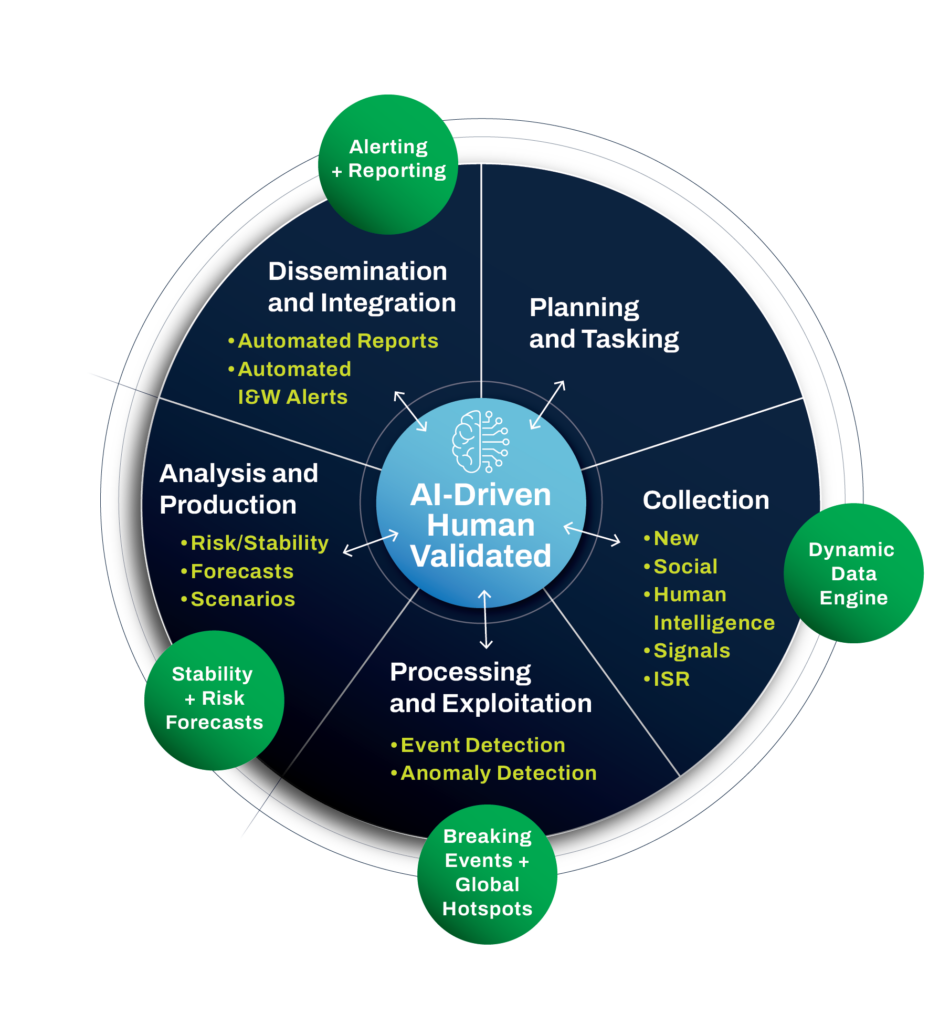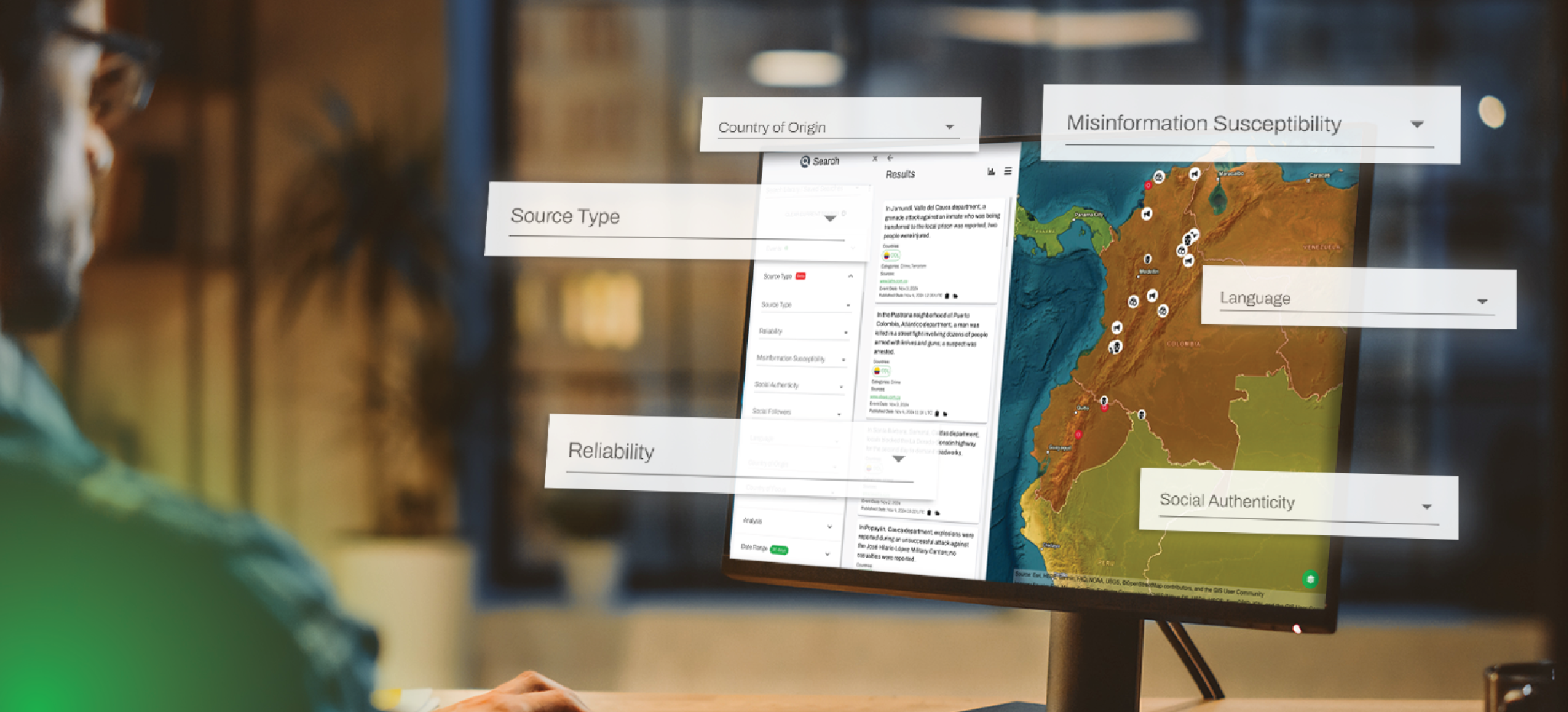Over the past few weeks, I have read numerous press releases, articles, and strategies discussing the evolving TCPED (Tasking, Collection, Processing, Exploitation, and Dissemination) cycle, the burgeoning role of OSINT (Open Source Intelligence), and the transformative impact of AI in intelligence and security operations. The Seerist team has been reimagining and building upon the classic intelligence process for the past eight years. By developing innovative approaches that fuse AI capabilities with human expertise, Seerist has created technology to enable a dynamic, interdependent intelligence process. This approach promises to enhance the agility, accuracy, and overall effectiveness of intelligence and security operations, setting a new standard for the future of analysis.
The future of the intelligence cycle holds immense potential as we increasingly combine artificial intelligence with human analysis. By leveraging AI to handle massive data sets and automating routine tasks, and pairing it with human expertise to provide context and critical analysis, we can develop a more agile, responsive, and accurate intelligence process. This shift towards a more dynamic, interdependent intelligence process is illustrated below, which highlights the integration of AI-driven human-validated intelligence. Here’s how this transformation might look:
Mission Focused Intelligence: A Dynamic, Interdependent Intelligence Process
The traditional intelligence cycle has operated in a linear fashion, with each phase leading sequentially into the next. However, as intelligence needs evolve, this linear model becomes less effective. The future of intelligence processes demands a more dynamic, interconnected approach where tasks are performed simultaneously and continuously, allowing for more rapid and informed decision-making.

Planning and Tasking
Planning and tasking must be more proactive, driven by AI’s ability to predict potential threats, opportunities, and scenarios. AI can analyze vast datasets from diverse sources, identifying patterns and anomalies that suggest emerging risks. Human analysts validate these insights, set priorities, and approve collection efforts. This proactive approach ensures that intelligence efforts are focused on the most pressing and relevant issues, enhancing operational readiness and strategic foresight.
Collection
Collection can leverage AI to automate the gathering of information from a growing multitude of both classified and unclassified sources, including processed and analyzed news, social media, ISR, and more. AI-driven platforms continuously collect and analyze data from millions of sources, filtering out noise and highlighting relevant information. For instance, an AI system can identify and categorize OSINT sources alone or combine them with classified sources to indicate a rising threat. This allows human analysts to focus on interpreting the most critical information rather than spending time on rote data collection.
Processing and Exploitation
Processing and exploitation is seeing significant advancements through AI and machine learning. AI algorithms process incoming data in real-time, detecting events, anomalies, and trends. Machine learning models categorize information into various threat types, such as conflict, terrorism, or natural disasters. This automated processing reduces the time required to analyze data, allowing for faster response times. Human analysts then exploit this processed information, applying their expertise to assess the implications and significance of the findings, ensuring accuracy and context.
Analysis and Production
The analysis phase benefit greatly from the integration of AI and human expertise. AI systems provide initial assessments, identifying potential risks and forecasting future scenarios. These AI-generated insights can be validated and refined by human analysts, who bring critical thinking and contextual understanding to the process. This hybrid approach ensures that intelligence products are both comprehensive and accurate. Analysts can produce risk and stability forecasts, scenario analyses, and detailed reports that inform decision-makers about the potential impacts of various threats.
Dissemination and Integration
Dissemination and integration of intelligence has become more streamlined and efficient. Automated reports and AI-driven Indications & Warnings (I&W) alerts ensure that decision-makers receive bespoke, timely, and relevant information. These automated systems can continuously update stakeholders on emerging threats and ongoing risks. Human analysts play a crucial role in integrating these insights into broader strategic and operational plans, ensuring that intelligence is actionable and aligned with organizational goals.
Breaking Events and Global Hotspots
AI systems monitor for breaking events and global hotspots, providing immediate alerts and analysis. These systems will detect deviations from normal patterns, indicating potential crises. Human analysts will assess these alerts, providing context and recommendations for action. This proactive approach ensures that organizations can respond swiftly to emerging threats, minimizing their impact.
Dynamic Data Engine and Stability and Risk Forecasts
The backbone of this intelligence cycle is a dynamic data engine that continuously ingests, processes, and analyzes data. This engine will support real-time stability and risk forecasts, providing a forward-looking view of potential threats. By combining AI’s data-processing capabilities with human analytical skills, organizations can anticipate and mitigate risks before they materialize.
Moving Beyond the Cycle
Seerist has recently embarked on two innovative programs in collaboration with the Department of Defense aimed at reinventing portions of the intelligence cycle. These initiatives focus on developing next-generation Indications & Warnings (I&W) and enhancing the identification of misinformation and disinformation. By creating a process that seamlessly integrates analysts with advanced AI systems, Seerist seeks to identify leading indicators of change, trigger real-time analysis of breaking events, assess the authenticity of information, and provide context for automated scenario planning. This approach ensures that both AI-driven insights and human-validated data are utilized in comprehensive scenario planning, thereby providing a more accurate and actionable intelligence framework.
AI and Human Synergy Drive Real-Time, Adaptive Decision-Making
The integration of AI with human analysis in the intelligence cycle has redefined it from a linear to a dynamic, interdependent process, enabling any phase to be activated as needed based on evolving intelligence requirements. AI handles vast data streams—automating collection, categorizing events, and identifying anomalies—while human analysts bring critical validation and context. This AI-human synergy allows intelligence teams to initiate targeted collection, processing, or dissemination at any time, based on real-time insights and evolving situational needs. The benefits are profound: faster response times, enhanced situational awareness, and a more flexible intelligence framework that adapts instantly to new risks and opportunities, significantly improving strategic foresight and operational readiness. This approach, as embodied by Seerist, ensures intelligence is timely, accurate, and actionable, keeping decision-makers consistently informed and prepared.





